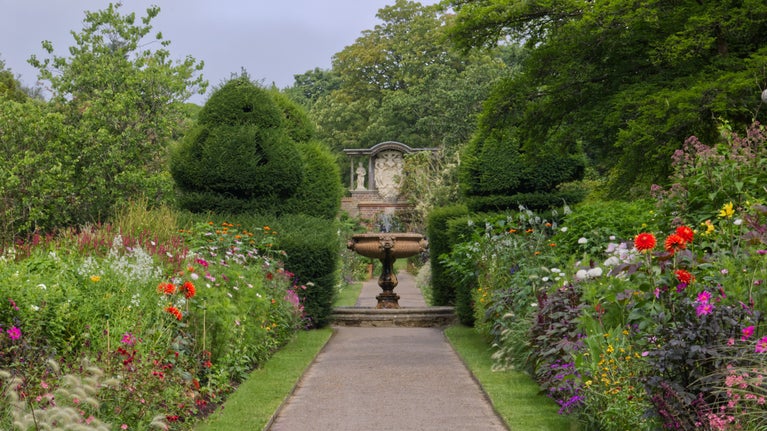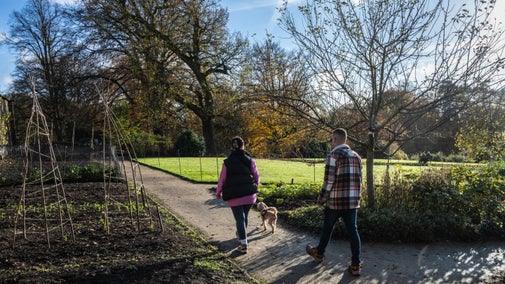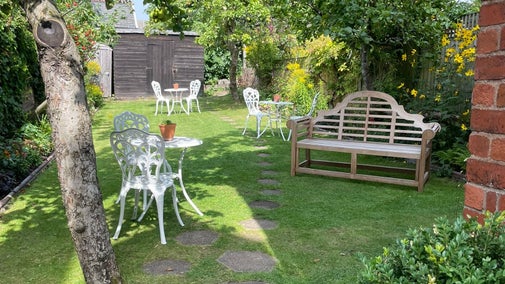
Gardens and landscapes
Find out more about the historical landscapes that the talented garden teams work hard to conserve at the places you love to visit.


Gardeners have long used sheltering structures to grow, protect and display plants year round. From the 17th-century orangery at Ham House to the 1920s greenhouse at Mr Straw’s House, the desire to cultivate rare and tender plants is an integral part of our horticultural history. Discover how innovations in glasshouse technology have informed building designs today, from the greenhouses in our gardens to central heating systems and even glass steel skyscrapers.
Since Roman times, people have longed to grow fruits and flowering plants from climates warmer than our own. It is from their resulting endeavours that the humble greenhouse of today emerged, bringing with it the ability to experience horticultural and culinary delights from across the globe.
One of the earliest surviving predecessors to today’s popular all-glass greenhouses is in our care – the contrastingly rare and solidly built Orangery at Ham House in Surrey.
Oranges are tender natives of China and South East Asia. Their flavour and decorative appearance led to them being grown in England from Elizabeth I’s reign.
Initially they were planted outside and protected over the winter by temporary covers. However, by the 1670s (the date of Ham’s Orangery), permanent buildings were constructed with large, south-facing windows to provide light to the plants that were grown in movable tubs. In the summer they would be placed in the garden.
Such orangeries were pleasant to visit and could also be used to house an increasingly varied range of half-hardy exotics, as well as for entertainment when empty in the summer.
They became a staple of the country house garden, increasingly elaborate and soon called greenhouses or conservatories because of the ‘green’ plants that were ‘conserved’ within.
There are many glasshouses and orangeries at the places in our care, and some of the most impressive are:
Up to the early 19th century, orangeries had little if any glazing to their roofs and it was the lure of two other fruits – the tropical pineapple from South America and indulgent grapes from the Mediterranean – that led to what we now recognise as a greenhouse.
Pitched glazed roofs were developed to maximise exposure to light. To provide the very high temperatures and moisture needed for pineapples and to extend the season for grapes, heating was introduced through hot air flues, by steam and eventually piped hot water – the origins of today’s central heating.
A magnificent ‘pinery-vinery’ for pineapples and grapes to be grown together was reconstructed in 2007 at Tatton Park, Cheshire. There are also several surviving or reconstructed vineries such as those at Greenway, Agatha Christie’s house in Devon, and at Quarry Bank in Cheshire.
Quarry Bank’s range of glass, carefully restored over the last few years, was constructed around 1820. At its centre, between the flanking vineries, is a projecting show house which boasts one of the earliest surviving examples of a curvilinear (rounded) iron frame.
… the greatest possible quantity of the sun’s rays, at all times of the day and at all seasons of the year
The curvilinear structure is of huge significance in the history of both glasshouses and architecture more widely. Ultimately, glass and steel skyscrapers of modern cityscapes owe their existence to the early 19th-century developments around glasshouses like Quarry Bank’s.

With glass becoming both cheaper and of larger proportions, and with heating becoming more effective, the numbers and types of glasshouses burgeoned during the 19th century. There now emerged tropical houses containing palms, amongst other things, as at Clumber Park.
There were also structures for ferns, orchids and carnations including the flamboyant Malmaison variety favoured for buttonholes. Others were designed for orchard trees, including peaches and figs and for house plants, cut flowers and, of course, the huge quantities of annuals needed for Victorian carpet bedding.
Cragside’s 1870s Orchard House is a prime example restored to full operation. It is divided into three parts with figs and grapes on one side, peaches and nectarines on the other, and pears, mulberries, apricots, plums, gages, lemons, grapefruit, mandarins and oranges in the middle. Each of the large earthenware pots sits on a turntable to allow the plant to receive even lighting and thus achieve consistent growth and ripening.
Although countless old glasshouses were taken down during the 20th century, the number restored or reconstructed continues to grow, and they have been joined by practical modern houses such as the one supporting the planting at Hidcote in Gloucestershire.
Nineteenth-century mechanisation brought glasshouses within reach of the middle class for the first time. By the mid-20th century their distribution was widespread.
At Sunnycroft in Shropshire, home to the lawyer John Lander and his family, there is a surviving Edwardian conservatory. It was supplied by R Halliday and Co., who – at the other end of the scale – supplied the princely ranges at the Rothschilds’ Waddesdon Manor in Buckinghamshire.
The Straw family ran a grocery business in the small town of Worksop in Nottinghamshire and their 1920s greenhouse is of a standard type found across suburban Britain. Amongst their books is A J MacSelf’s 'The Amateur’s Greenhouse' which was bought for 7s 6d (35½p).
No show can be put on without backup – every garden in our care, large or small, would have had garden sheds supporting the glasshouses.
At Quarry Bank there were separate spaces for the potting shed, the tools, the storage of produce and seeds and the growth of mushrooms; there was also a boiler house, a bothy for gardeners, the head gardener’s office and even a privy. At Lindisfarne Castle on Holy Isle, there is a single, charming shed designed by Sir Edwin Lutyens in the early 20th century.
Many of these sheds remain in use today, critical to the running of the garden as much now as they were when first built.

Find out more about the historical landscapes that the talented garden teams work hard to conserve at the places you love to visit.
Discover the impressive and inspiring range of houseplants you’ll find on display in the conservatories, orangeries and glasshouses in the Trust’s care.

Discover some of the finest historic gardens in our care and how they were shaped by Victorian plant collectors, as they gathered plant species from across the globe.

Wander through our collections and gardens to learn the high-society origins of the ferns, orchids and pelargoniums in your home.

Wander through the dramatic valley garden, stroll by the river and tune into the sights and sounds of the season as you explore this rare retreat where nature and industry collide.

Discover more about the Halliday Conservatory at Sunnycroft, and our work to conserve it.

Discover a paradise garden in Wales, with 300 hundred years of garden transformation providing many layers of history to explore.

Find out about the great outdoors both near and far through the Straws’ love of cacti and homegrown produce, and their interest in walking through town and the local rights of way.

From walled gardens to riverside woodland, the garden at Greenway is very relaxed and tranquil. Find out more about the Peach House, the Fernery, the Battery, and where to find the best river views.
